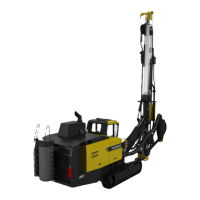SmartROC D65 Tier 4 Final 2 General
25
Over a length of Over a length of
6d 30d 6d 30d
201 - 220 9 18 4 9
221 - 240 10 19 5 10
d = Cable diameter
1
= Filler wire is not considered load-bearing.
In cables with several layers of strands, only the outer, visible layer is considered.
In cables with steel cores, the core is regarded as an inner strand and is not included.
2
= In the event of a wire break, two ends can be visible.
Corrosion
Corrosion is especially problematic in marine environments and in areas where the air is
polluted by industrial emissions.
Corrosion can reduce operational strength through rust spots and static tensile strength
through a reduction in the cross section of the metallic cable.
Severe corrosion can reduce elasticity.
Outer corrosion: Outer corrosion can be easily detected through visual examination.
Inner corrosion: Inner corrosion is more difficult to detect. Inner corrosion is character-
ised by the following:
n Absence of gap between the strands in the outer layer of the cable, often in combina-
tion with wire breaks in the strands.
n The cable diameter varies.
The parts of the cable that are bent over discs usually have a decreased diameter. At any
sign of corrosion, the cable should be checked by an authorised person. If inner corrosion
is detected, the cable must be scrapped.
Surface wear
Inner surface wear is caused by friction between the wires and the strands.
Outer surface wear is caused by friction between the cable drums (rolls) and the cable un-
der pressure (acceleration and braking). Outer surface wear is visible through the forma-
tion of reflected images on the outer wires.
Surface wear is increased through faulty or no lubrication, thereby increasing the effect of
dirt and dust.
Surface wear reduces static tensile strength through reduction in the cable's metallic cross
section and dynamic strength through surface wear nicks.
If the cable's diameter decreases more than 7% in relation to the nominal diameter of the
cable, it must be scrapped.
It should then be scrapped even if no wire breaks have been detected.
Deformation of the cable
Deformations are characterised by visible deviations from the cable's normal form that lead
to uneven voltage distribution in the cable.
The following are the primary types of deformations:
n Wire displacement

